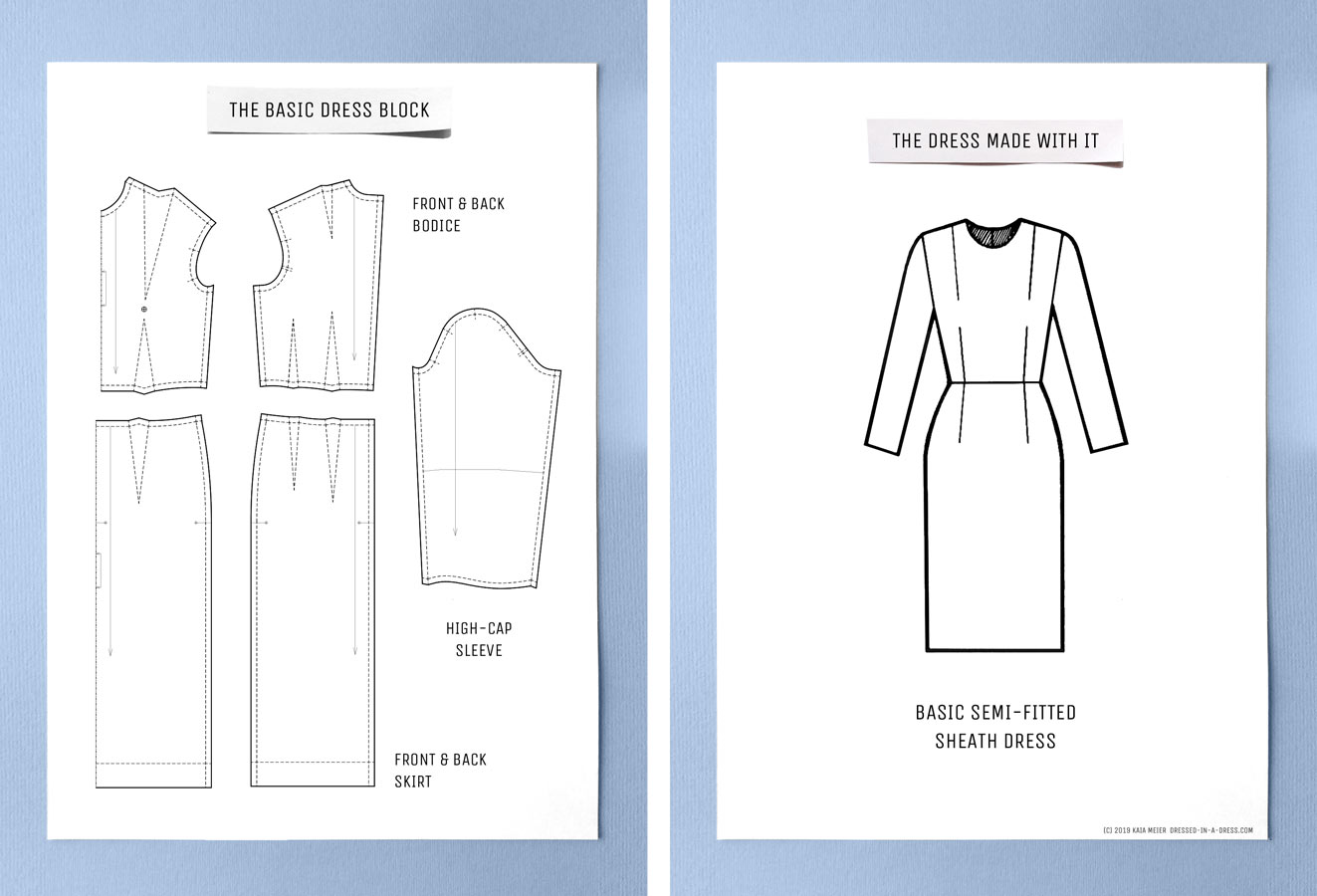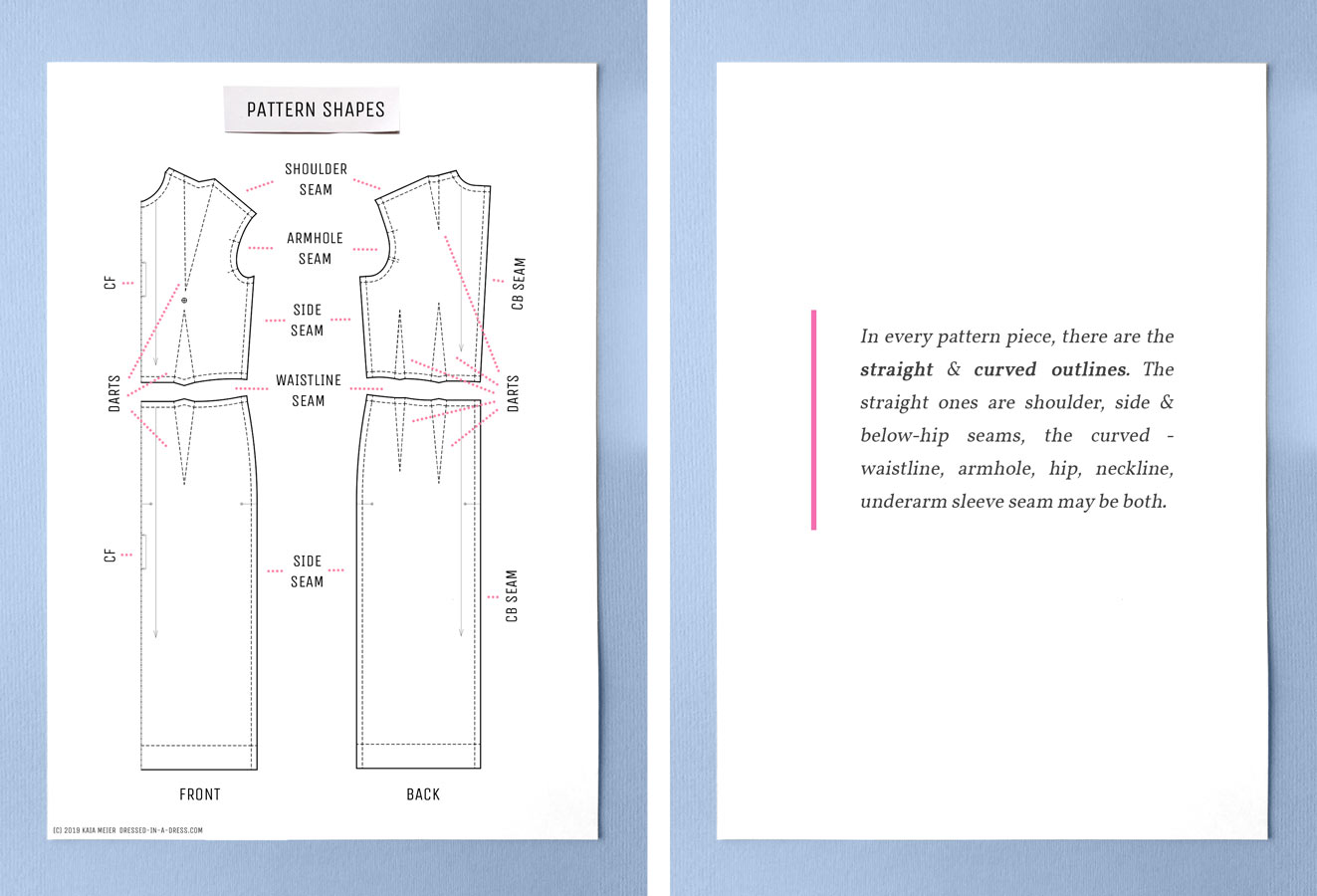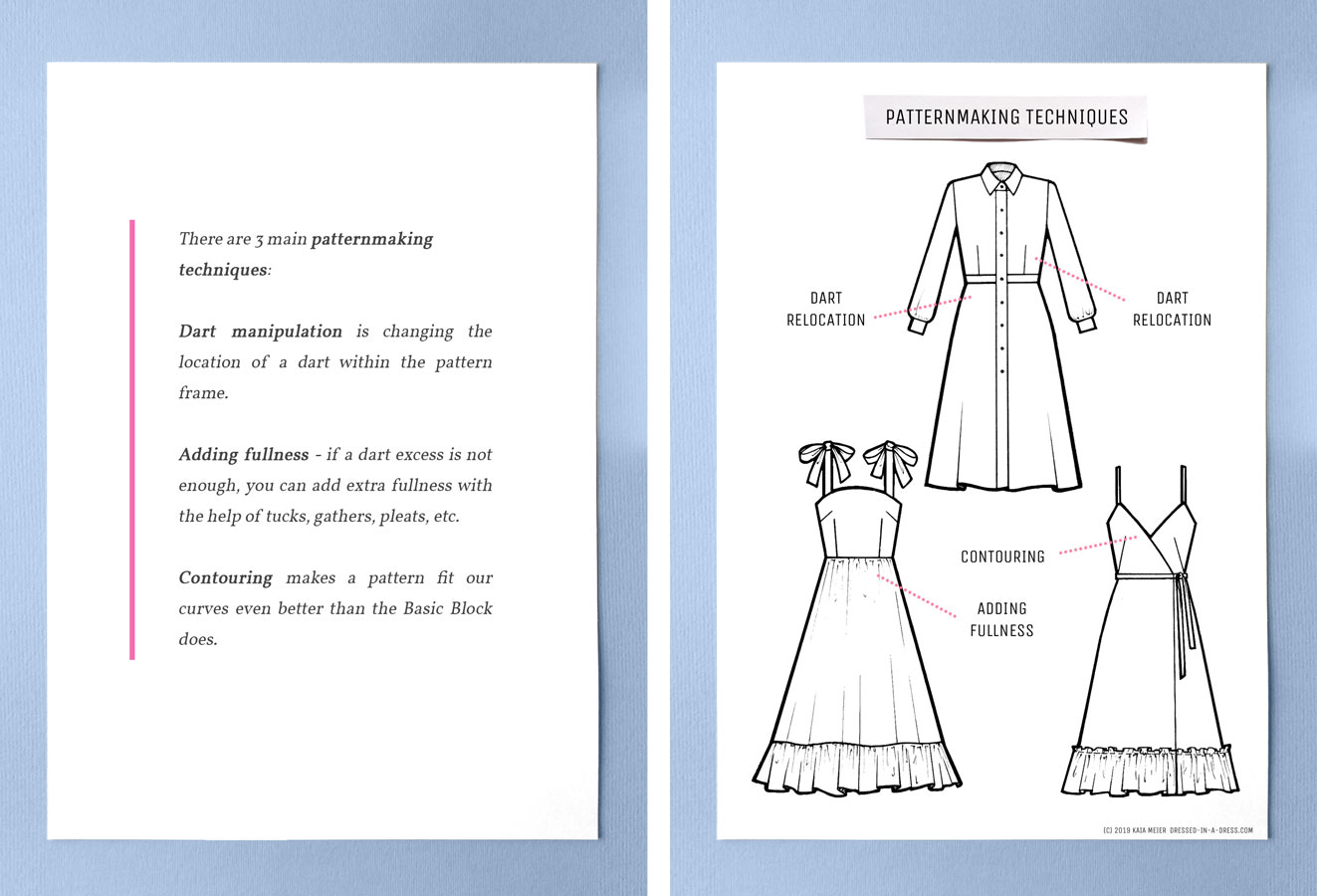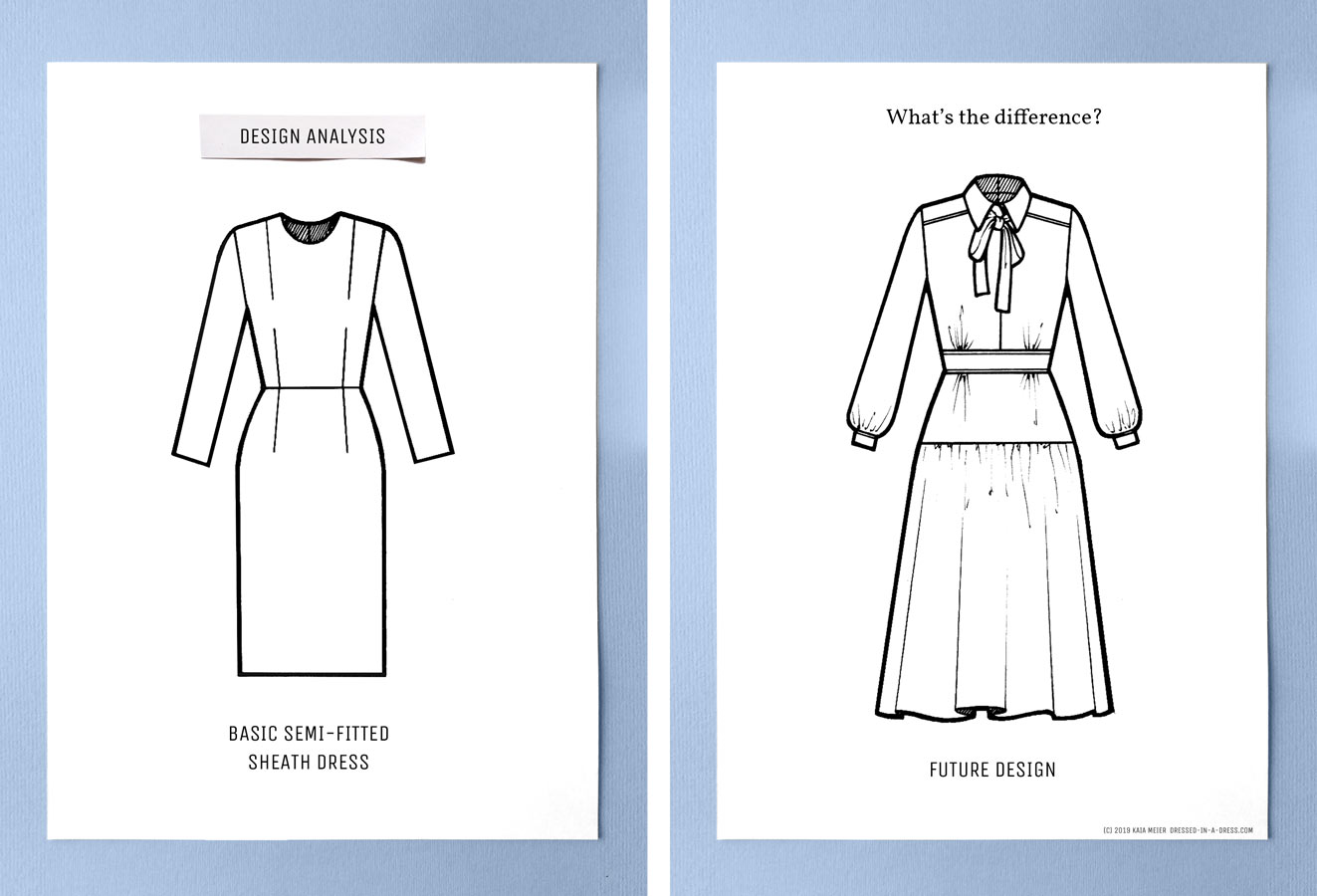02. Pattern Shapes & Flat Patternmaking
Category: Patternmaking Series 05 February 20
After learning what block patterns are, let’s take a closer look at a basic dress block and what one needs to know to make other dresses from it.
Pattern Shapes
Here you can see a 5-piece basic block for a semi-fitted dress made of non-stretchy woven fabric. There are front and back bodice pieces, front and back skirt pieces and a wrist-length set-in sleeve.
From now on, I’ll be using this set to show different pattern manipulations. Transformations—not all, but most of them—and what’s the most important, its principles can be applied to different block patterns: jackets, coats, blouses—whatever you like. The main goal is to understand the reasons and the process itself.

The number of pattern pieces may vary depending on the patternmaking system: some offer full front and full back details, that you can cut later if needed, others have the pre-divided bodice and skirt pieces. It doesn’t matter how many pieces you have, as long as you get your desired fit.
But how does a 2-dimensional pattern transform into a 3-dimensional garment?
Lately, we talked about a basic block pattern following the contours of our body. In every pattern piece, there are the straight and curved outlines. The straight ones are shoulder, side and below-hip seams, the curved—waistline, armhole, hip, neckline; an underarm sleeve seam might be both.

But even with this combination of straight and curved lines, the pattern will still be 2-dimensional while our bodies are not. Here come the darts—those triangular shapes.
The Dart
Each piece of a basic block has darts and by transferring these darts around the pattern outline, one can get various styles. But what is a dart?
The dart is a folded wedge of fabric that confines unneeded fullness in certain areas to shape a garment to body curves.
That amount of excess space is called dart intake. You can see it between the two dart legs. Dart legs are the two lines meeting at the dart point. Dart points should stay close to the apex of the bust, shoulder blade, buttock, abdomen and even elbow. A well-sewn and pressed dart gradually releases the intake and disappears at the apex point.

Depending on the body type and curves, the number of darts may vary slightly: there may be two waist darts in the back and two in the front; someone may need one or two darts in the back and one in the front.
But darts are not only good for the fit, but they also offer several design possibilities: they can turn into fashion seams, tucks or gathers, of which I’ll write in upcoming posts. But first, let’s see what techniques and methods will help us manipulate darts and make other alterations to the pattern.
Flat Patternmaking Methods
First of all, let’s clear what flat patternmaking is.
Flat patternmaking is a system of pattern manipulation, in which previously created patterns—basic or fashion blocks—are modified to develop new various styles.
It is a fast and efficient method that maintains the consistency of size and fit of mass-produced garments.
To transform this block pattern into a final, or, in other words, design pattern, one can use two patternmaking methods:
- Slash
- Pivotal.
You don’t need to choose only one method—both will appear through your patternmaking way.
Slash method: according to the name, the pattern is slashed and spread or overlapped for dart relocation, adding more fabric or creating a closer fit.
Before you start making any alterations to the block pattern, please, copy it. I’m not kidding. Never cut your block patterns and do store them safely. Take 5–10 minutes to trace them onto transparent paper, because drafting a new basic block every time you’d like to have a unique design will take away much time.
Once you slash and tape the block pattern copy, trace it onto a new sheet of paper to get the design pattern.
In the pivotal method, the pattern is not slashed but rotated around the pivotal point for dart relocation. It is a faster and more efficient way, though the method is based on the knowledge gained from slashing the pattern.
Flat Patternmaking Techniques
Above I mentioned three main patternmaking techniques:
Dart manipulation is changing the location of a dart within the pattern frame.
There are many rules and options for changing the dart location, of which we’ll talk later. At this moment, remember: if the dart remains directed to its pivotal point, you can shift, rotate, divide and combine it with other darts and still have the same fit as in the basic block dress. This way or the other darts will be a part of the design if you want to keep the exact fit. You cannot just pretend the dart isn’t there.
By adding fullness, you can get extra volume with tucks, gathers and pleats (if dart excess is not enough).
In this case, the pattern becomes longer or wider, so you might need extra fabric. Unlike a dart, added fullness doesn’t direct to the pivotal point.
Contouring makes a pattern fit our curves even better than the basic block does—this happens with the help of new darts or the curved shape of the existing dart legs.
New darts help avoid gapping ease at plunging necklines and armholes in sleeveless and strapless designs. Curved darts give closer fit under bust. If we keep the dart legs of a front waist dart straight, the fabric will go from the bust pivotal point right to the waistline, but if we draw curves, the pattern will replicate a bust’s shape. That could be a pretty elegant and feminine touch to a dress.

These three fundamental techniques are not the only ones you should master with time: there also design elements like necklines, yokes, plackets, collars and pockets and support elements like facing. But don’t worry about them now.
Prepare for pattern manipulation
Once you read all of the above, drafted your basic block and found an idea for a new design, take some time to think of the upcoming patternmaking process. Let’s divide it into four steps:
Analyze your new design. Ask yourself: “What is the difference between my design and the block I’m using?”. Maybe you have gathers instead of darts or you have a pleat at the back. If needed, write it all down.
Identify which patternmaking techniques you’ll need to apply. It may be tricky initially, but we have three main techniques, so try to start with them.
Identify which design and support elements your garment will have. The spectrum of them is pretty broad, so there will be the things left in your list “what’s different between my design and the block”.
Make the design pattern—this will take time. You can trace the existing block and cut and tape the copy for slashing method, or you can use the block to draw the new pattern by the pivotal method. To finalize the pattern you’ll need to check it, add seam allowances and notches if missing.
Extra step: pour yourself a good cup of coffee or tea and take something sweet—you deserved it.

Get ready for following posts
Before we part for another week, take a look at the list and a PDF attachment below. There you can find a 1:3 scale 5-piece basic dress block pattern. We are going to need this during the following weeks for practice.
Here’s what you can do with with the file:
You can download the basic dress block and print on heavyweight or usual paper.
Cut out the basic block pieces.
If your paper was thin, carefully glue pattern pieces to the cardboard of preferred weight. The better the cardboard, the longer this set will last.
Let the sheets dry under a pile of books—this will prevent creases.
Cut the pieces out again.
With a thick sharp needle or an awl make neat holes at the dart and pivotal points.
And finally, that’s all for today. In the next post, we will be manipulating darts. So, don’t forget your pencils, pens, rulers and paper—both usual and transparent—and check the 03. Common Dart Manipulations post; it will tell about two-dart designs.
Yours,
Kaia
